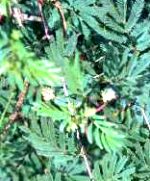 Also called prairie mimosa and prickleweed, this herbaceous perennial is a member of the pea family, Fabaceae, that also includes lupines, mimosa, and black locust. It is native to the midwestern US where it grows in fields, prairies, riverbanks, and waste areas such as roadsides and train right of ways. Plants grow 1-5′ tall and have a grooved light green stem that is unbranched or sparingly branched. The bipinnately compound leaves are up to 8″ long and have a fern like appearance. The subleaflets are medium to light green, 1/8″ long, and fold up at night. From June to August, clusters of 30-50 white flowers appear on short stems in the axils of the upper leaves. Each flower has long protruding yellow stamens that give a brush like appearance. Clusters of 5-15 dark brown seed pods 1/2″ long follow the flowers. The flowers attract small bees and flies seeking nectar and pollen, the seeds are consumed by gamebirds including pheasant and quail, and the foliage is eaten by various mammals such as rabbits and deer. Because of a high protein content, Illinois bundleflower is considered a valuable range plant. The genus name, Desmanthus, comes from the Greek words desme meaning a bundle and anthos meaning flower and refers to the appearance of the flowerheads. The specific epithet, illiniensis, refers to the geographic location of the plant.
Also called prairie mimosa and prickleweed, this herbaceous perennial is a member of the pea family, Fabaceae, that also includes lupines, mimosa, and black locust. It is native to the midwestern US where it grows in fields, prairies, riverbanks, and waste areas such as roadsides and train right of ways. Plants grow 1-5′ tall and have a grooved light green stem that is unbranched or sparingly branched. The bipinnately compound leaves are up to 8″ long and have a fern like appearance. The subleaflets are medium to light green, 1/8″ long, and fold up at night. From June to August, clusters of 30-50 white flowers appear on short stems in the axils of the upper leaves. Each flower has long protruding yellow stamens that give a brush like appearance. Clusters of 5-15 dark brown seed pods 1/2″ long follow the flowers. The flowers attract small bees and flies seeking nectar and pollen, the seeds are consumed by gamebirds including pheasant and quail, and the foliage is eaten by various mammals such as rabbits and deer. Because of a high protein content, Illinois bundleflower is considered a valuable range plant. The genus name, Desmanthus, comes from the Greek words desme meaning a bundle and anthos meaning flower and refers to the appearance of the flowerheads. The specific epithet, illiniensis, refers to the geographic location of the plant.
Type: Herbaceous perennial
Bloom: Clusters of white flower
Size: 1-5′ H x 2-3′ W
Light: Full sun to partial shade
Soil: Average to lean, dry to medium moist, well-drained; drought tolerant
Hardiness: Zones 5-8
Care: Low maintenance
Pests and Diseases: None of significance
Propagation: Seed
Companion Plants: Not applicable